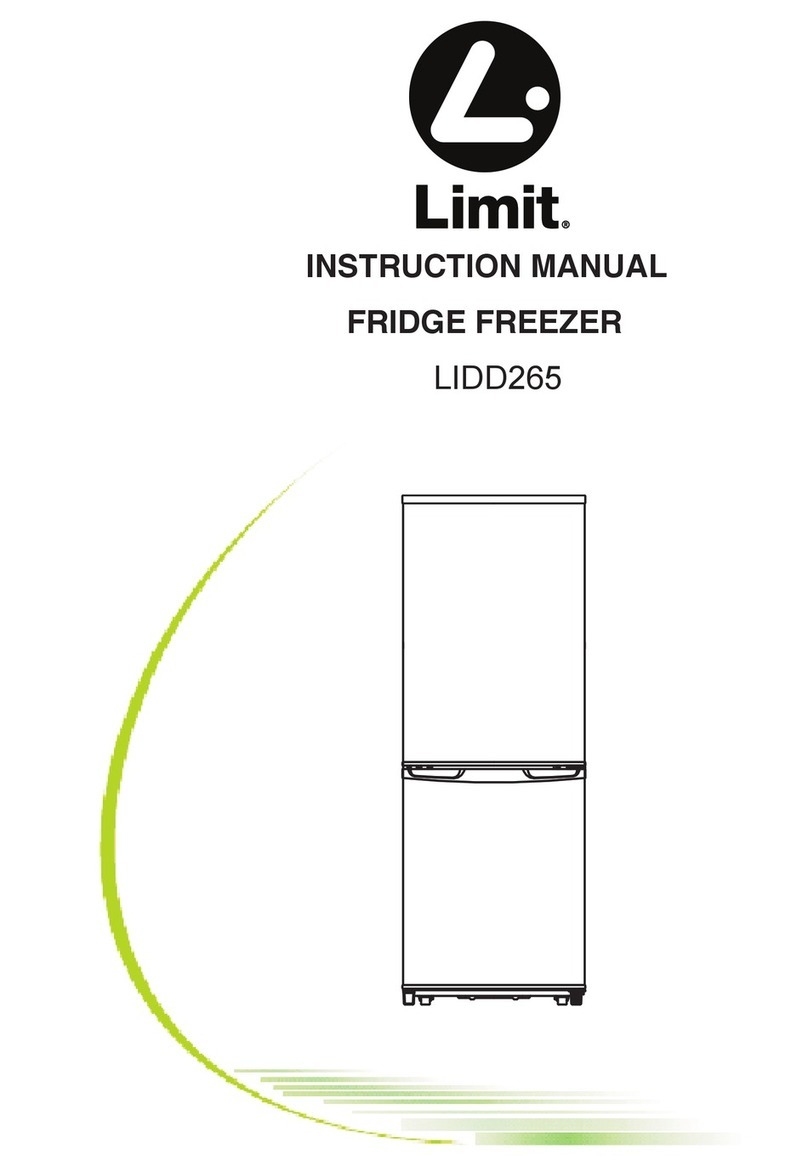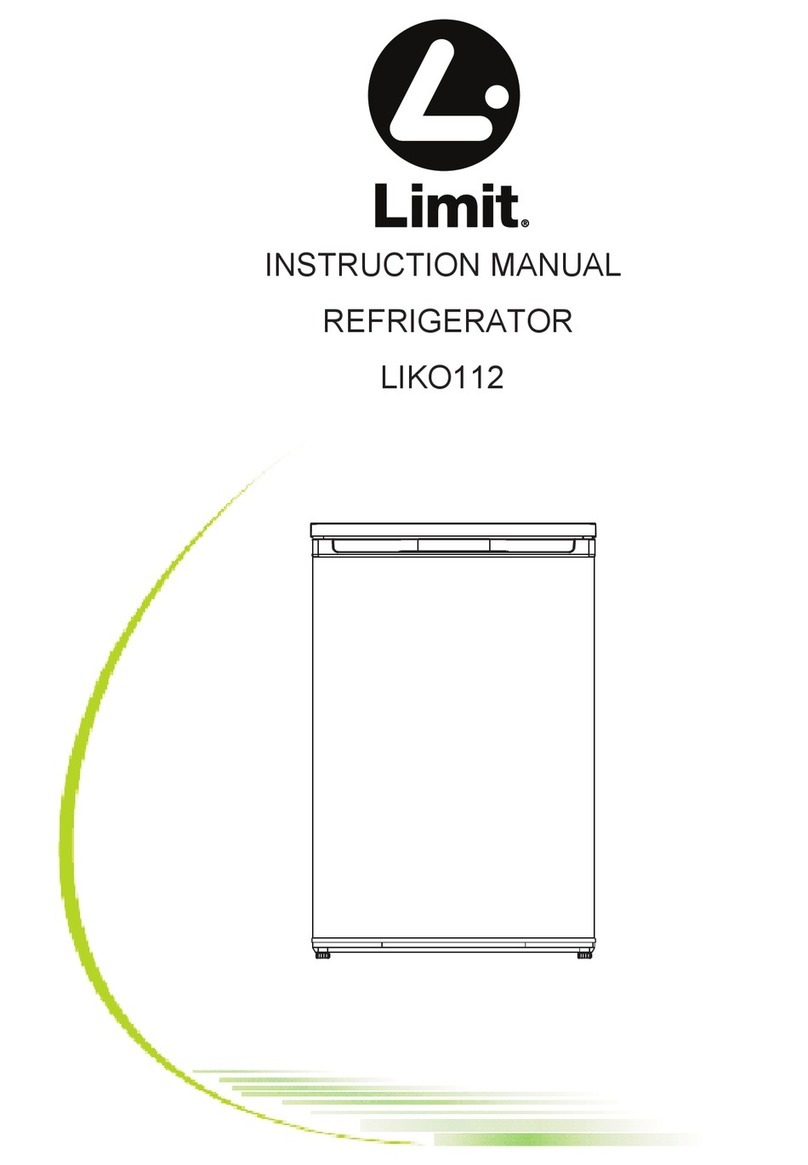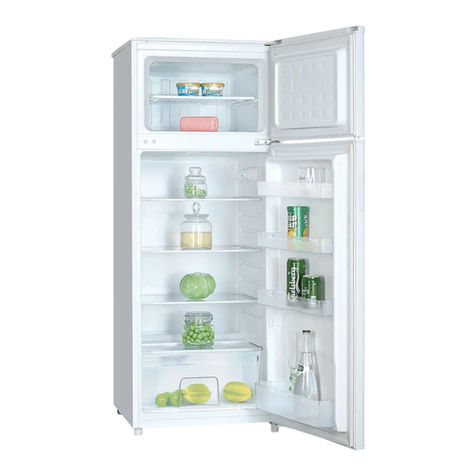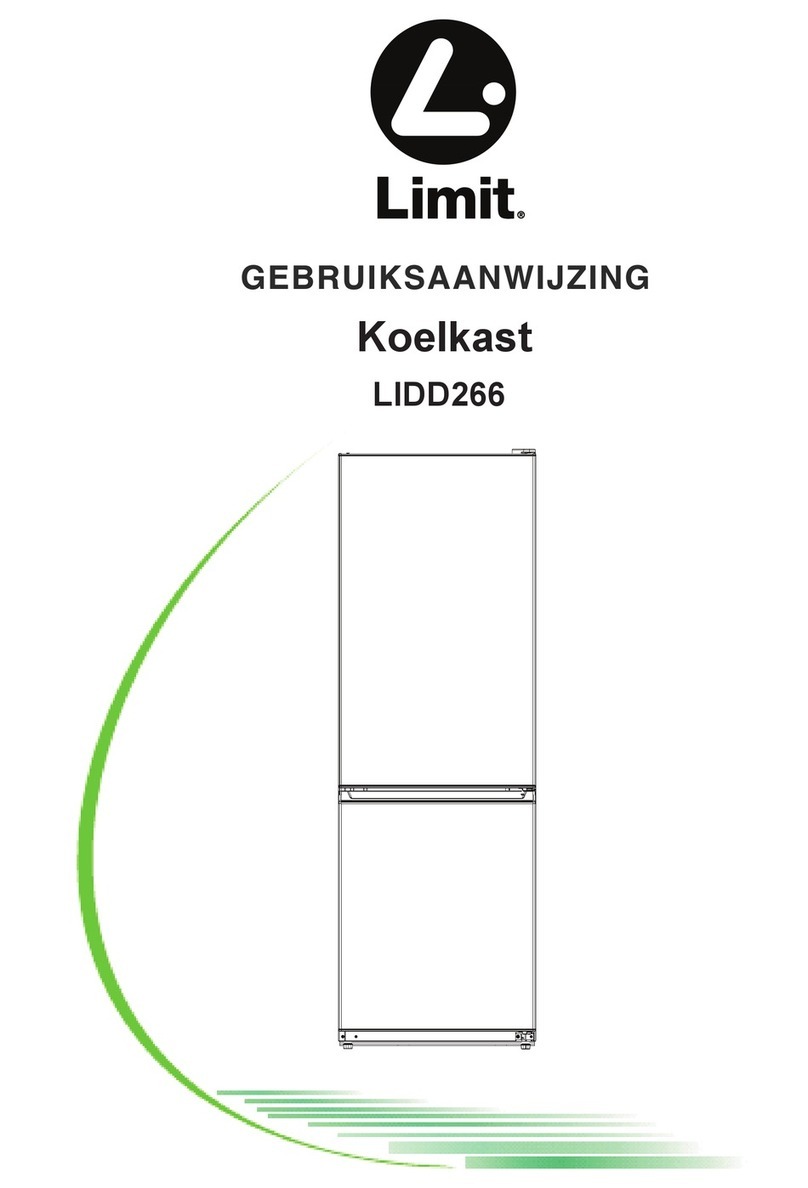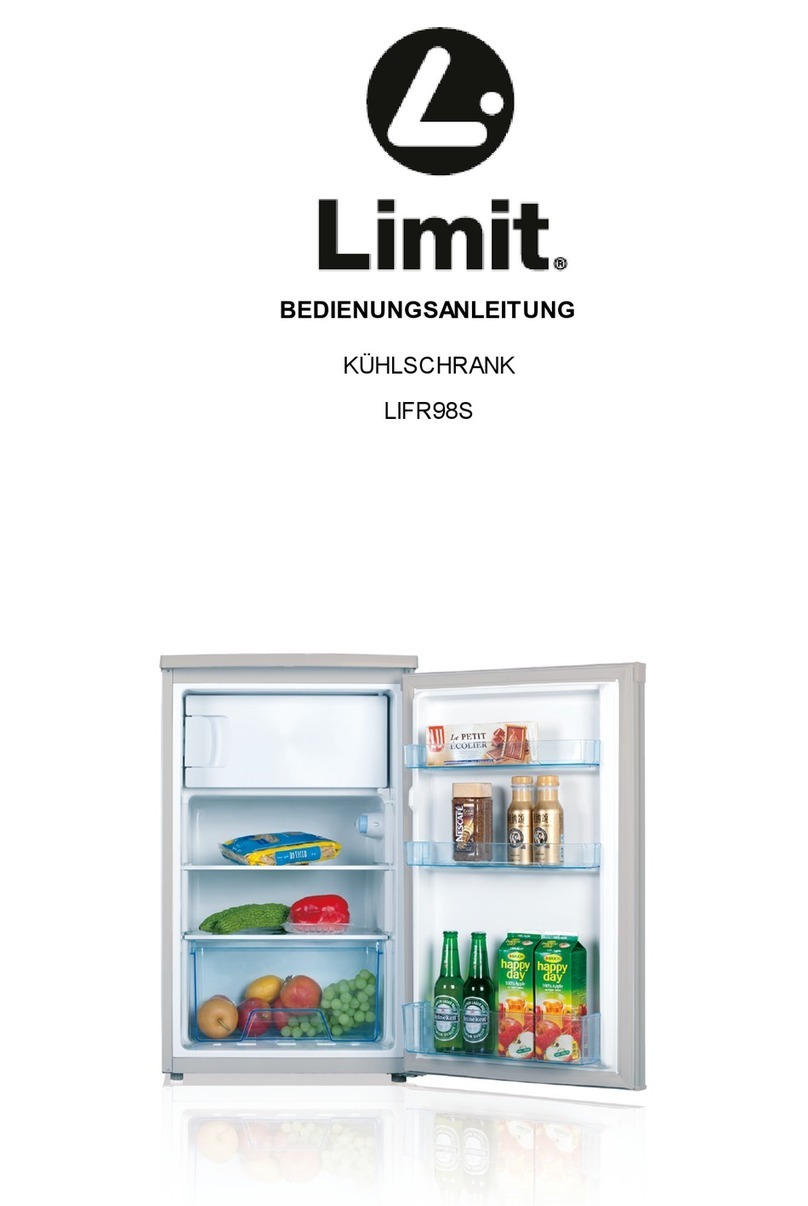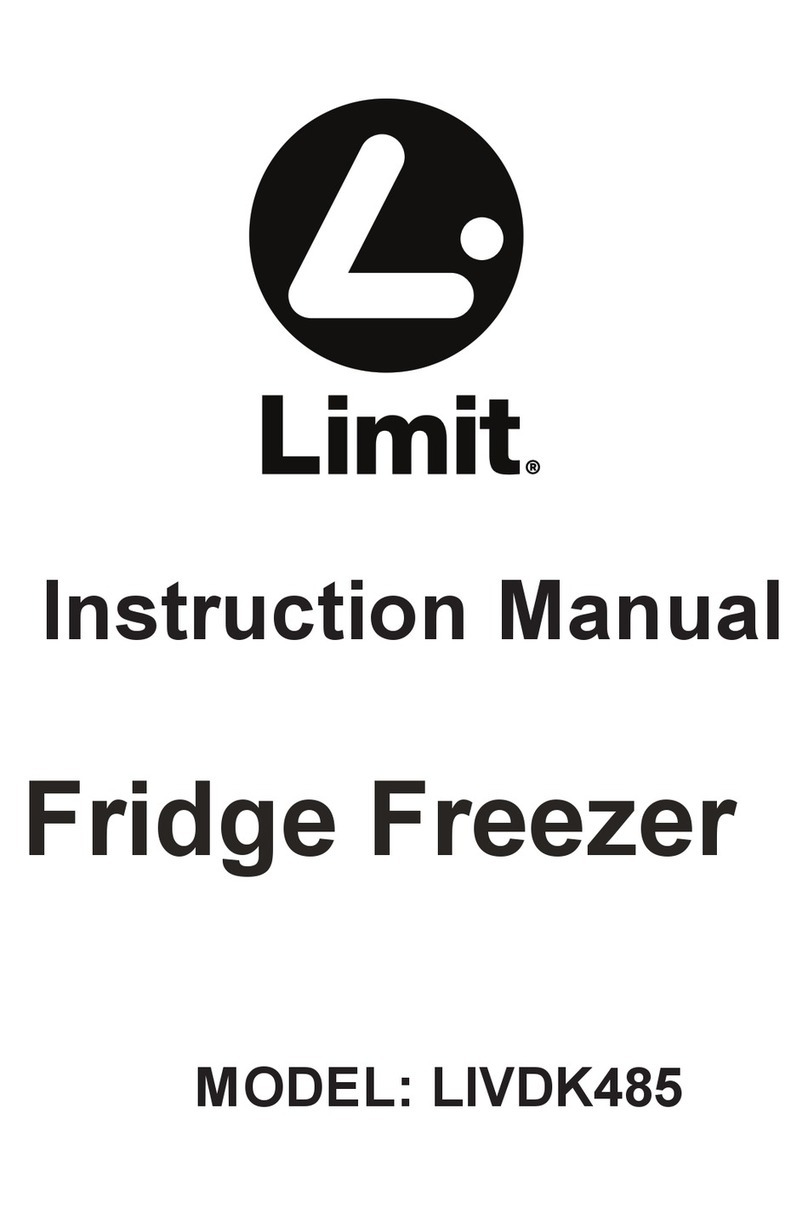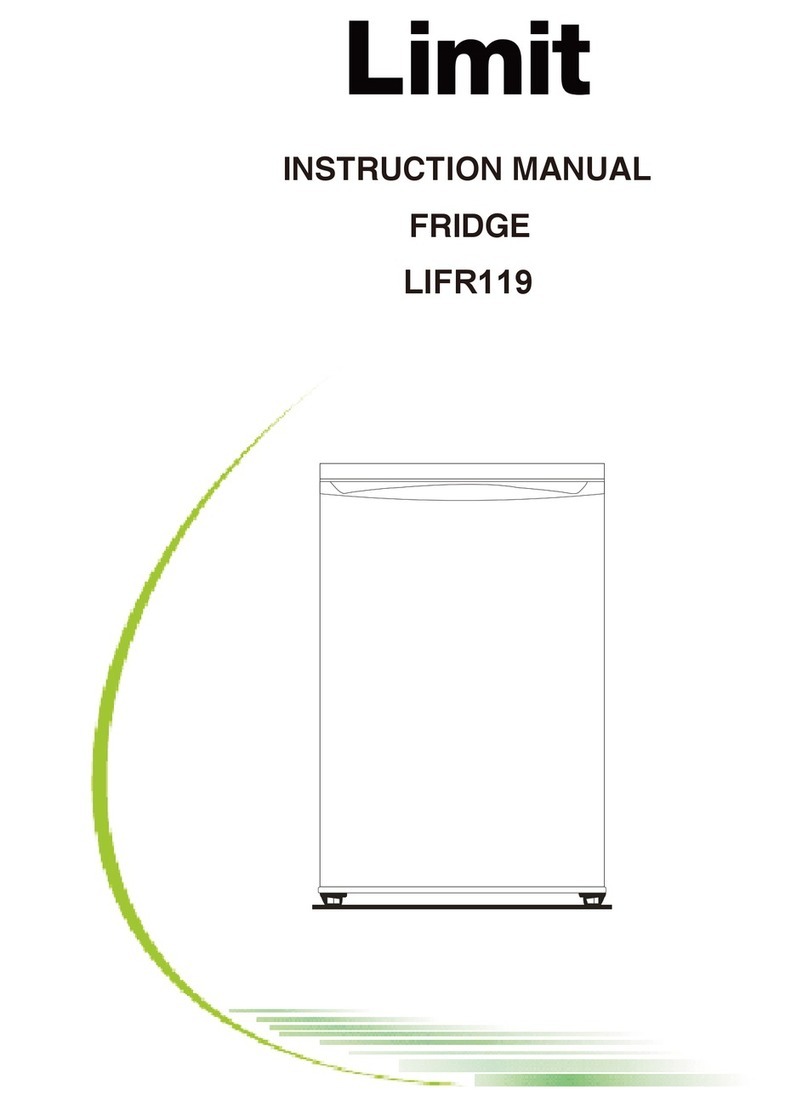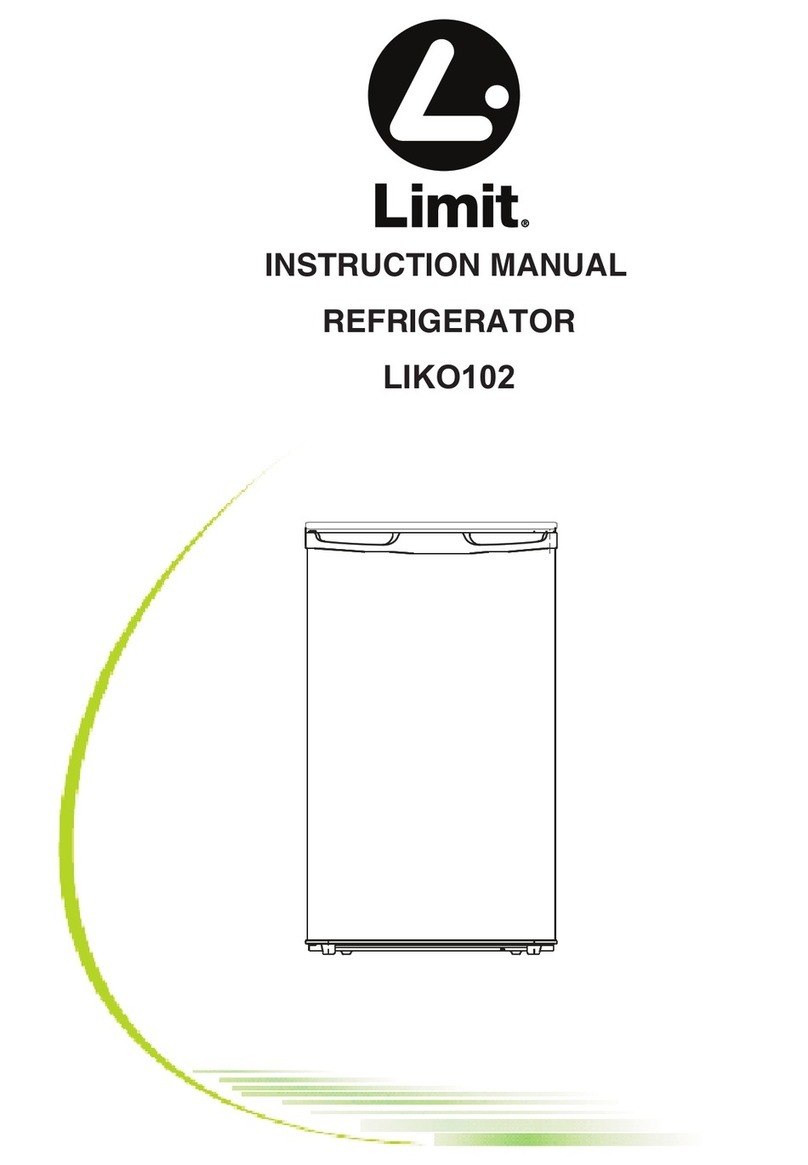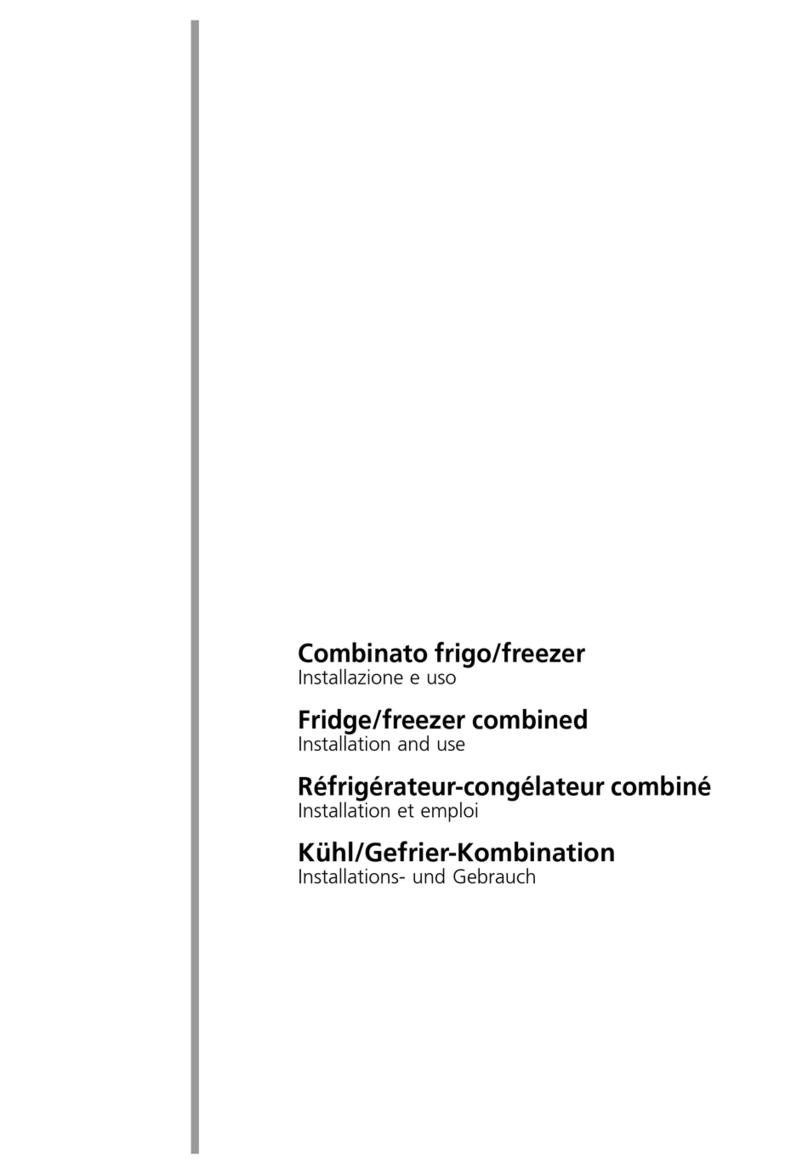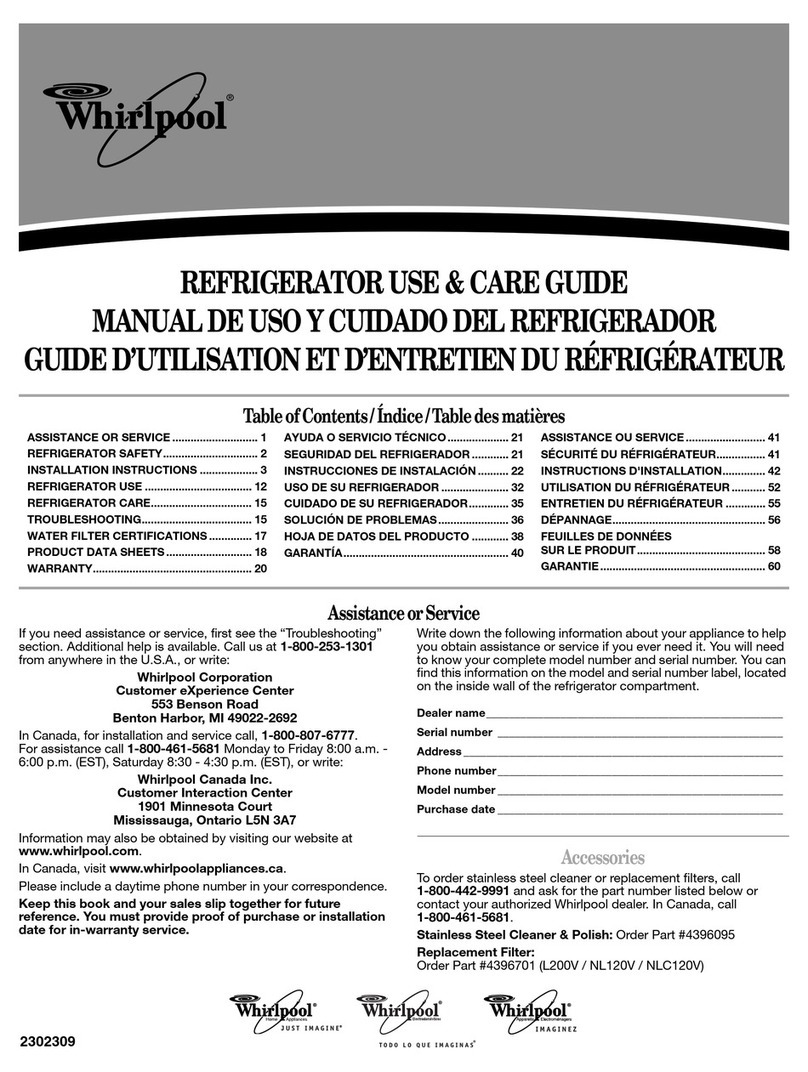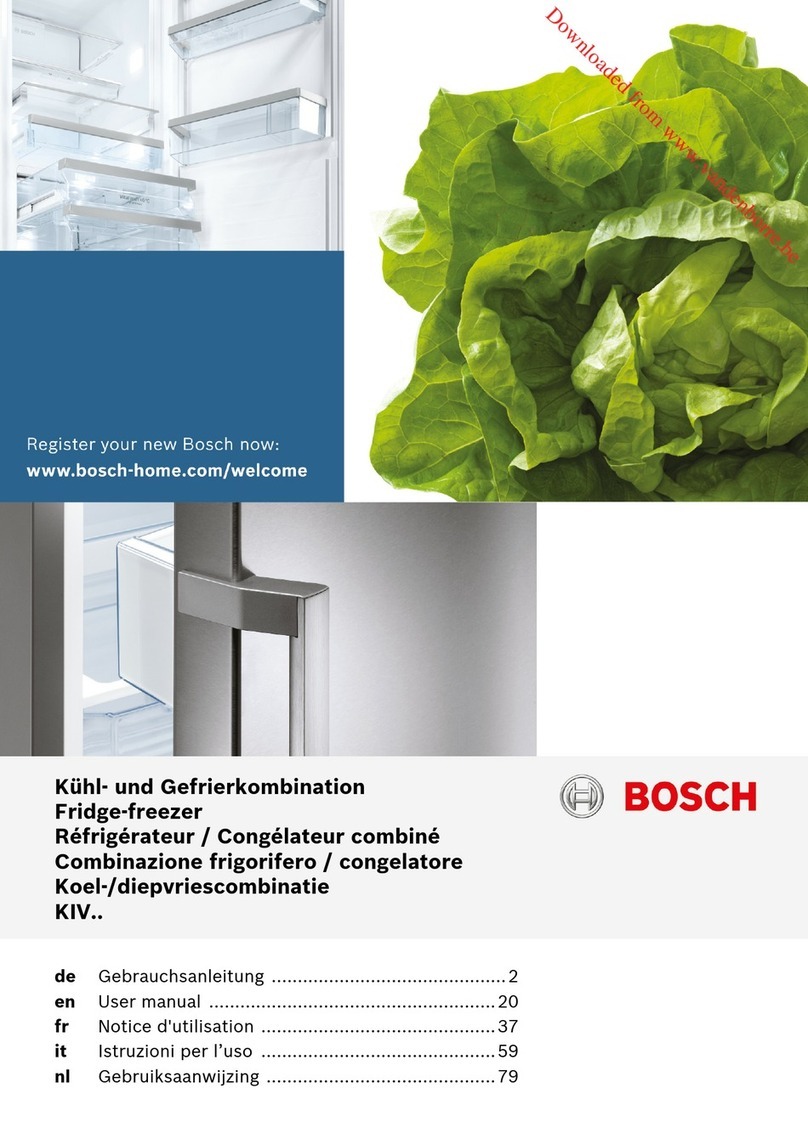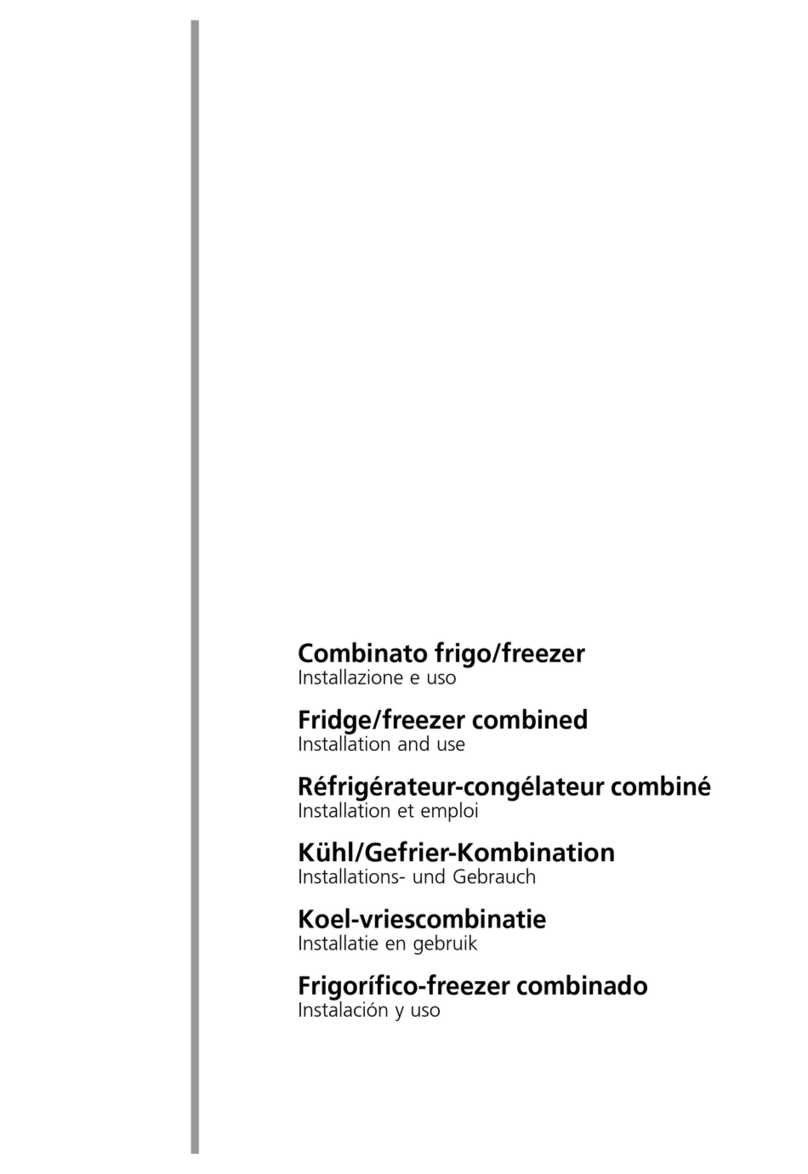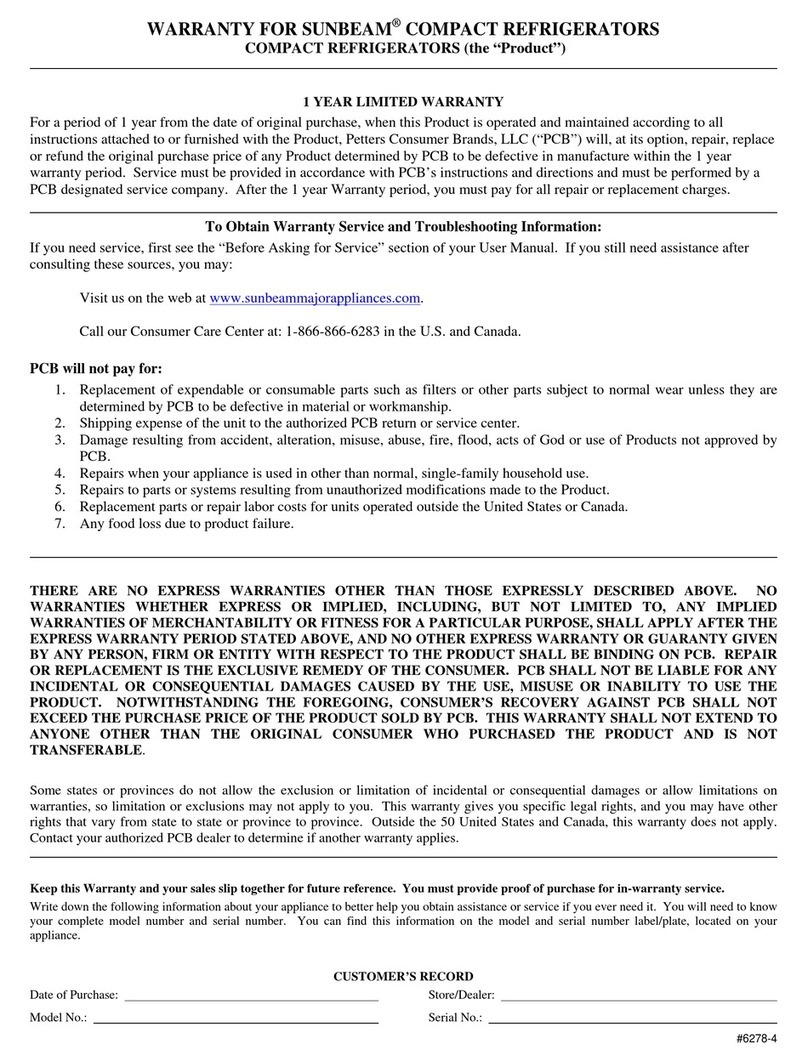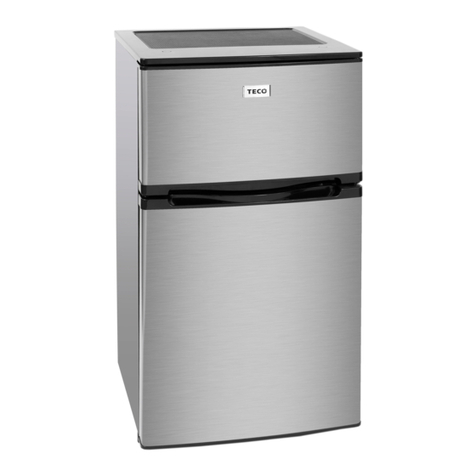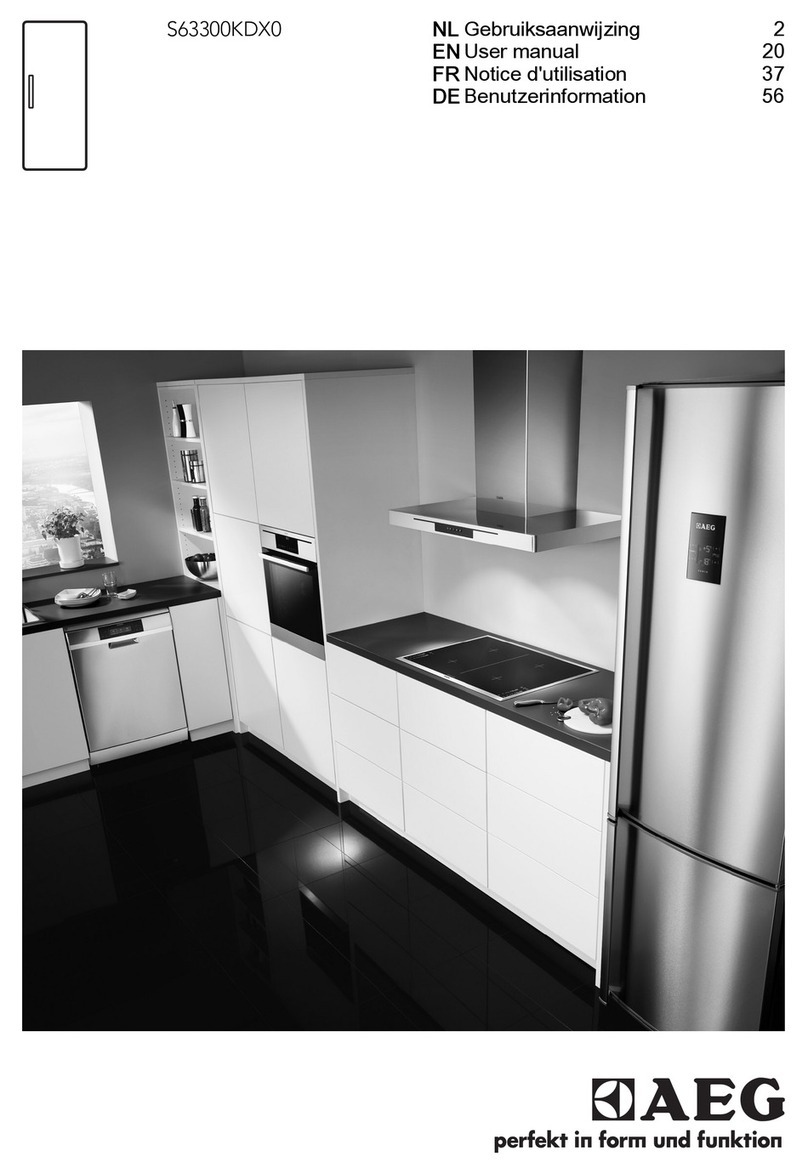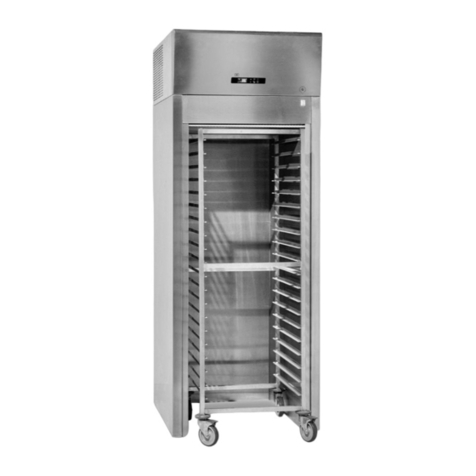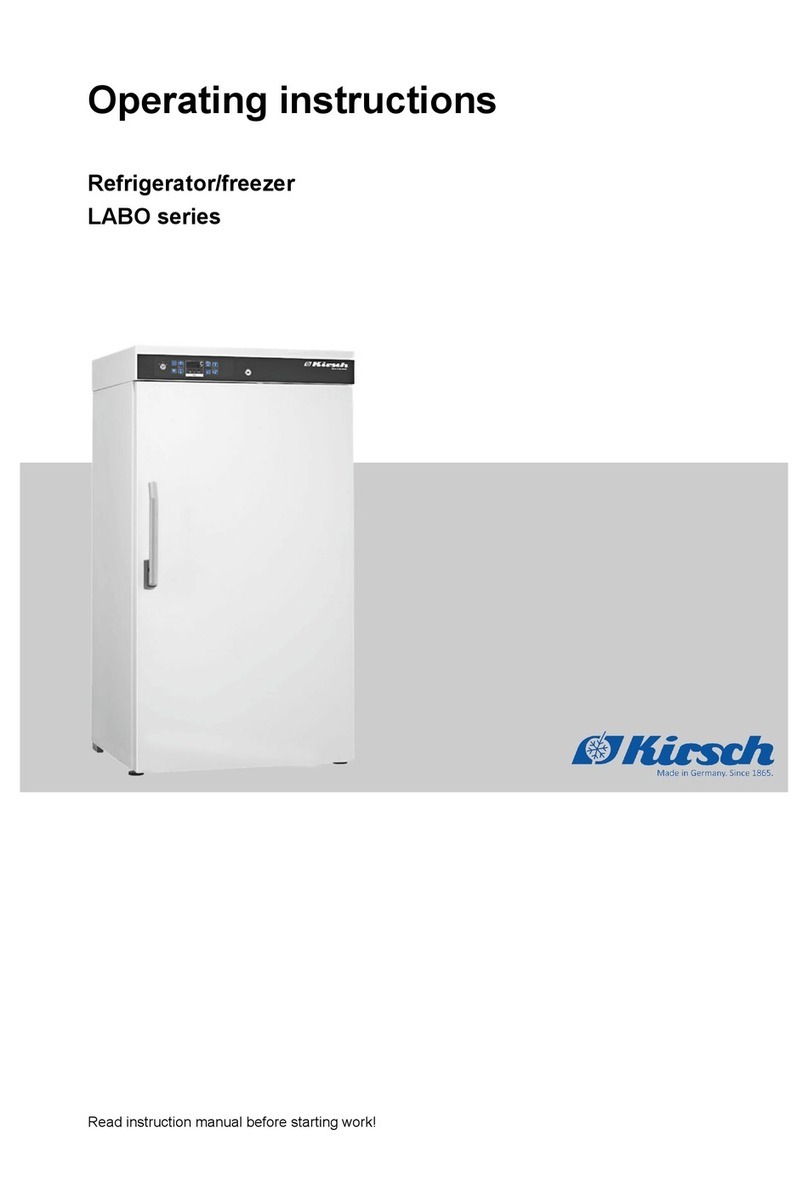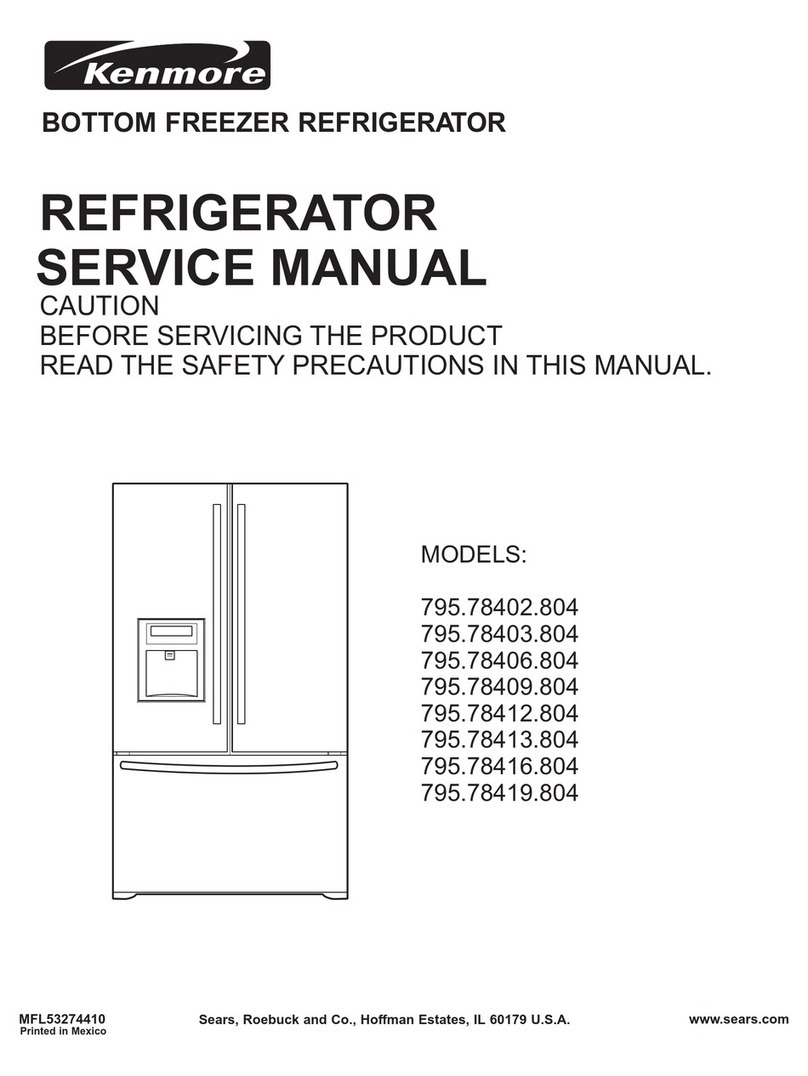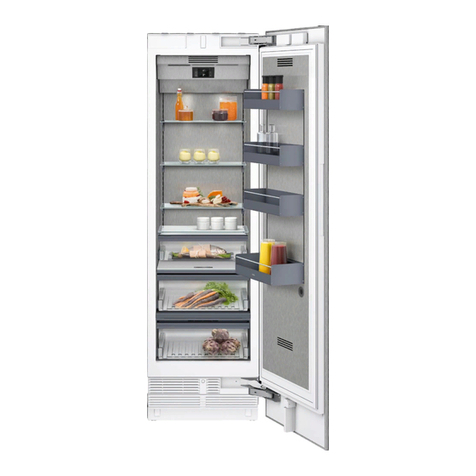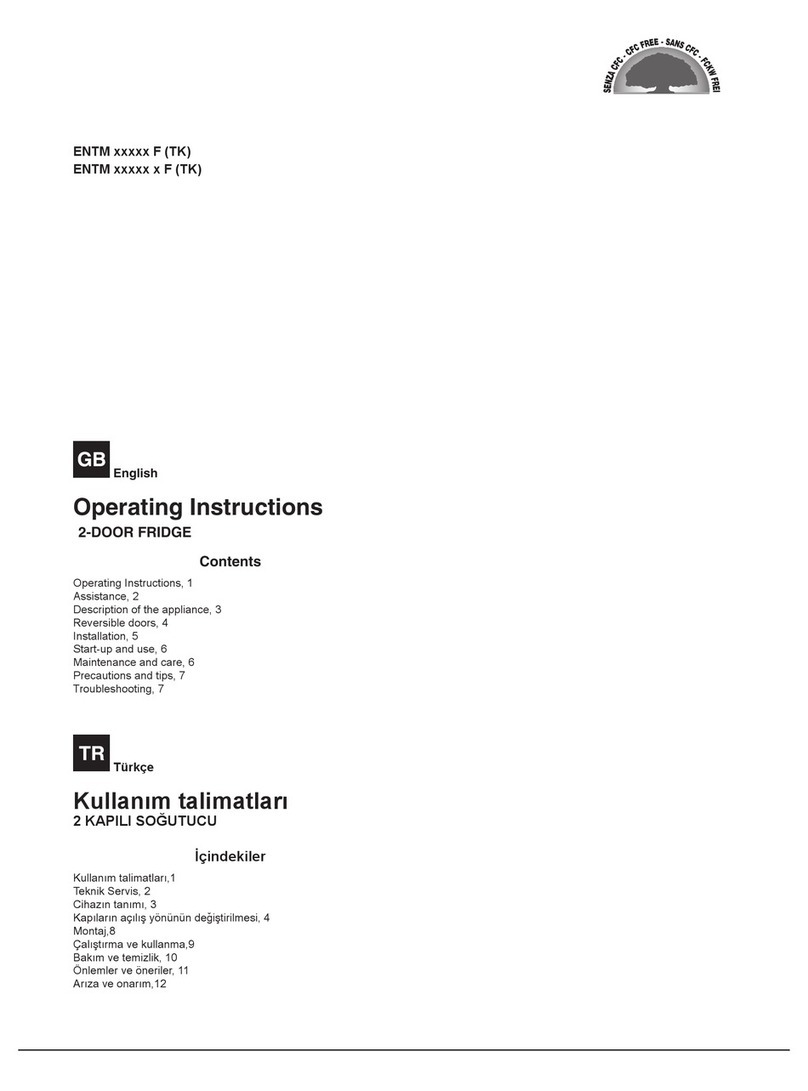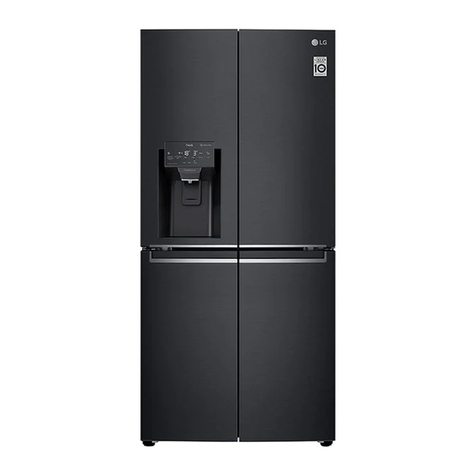LIMIT LIDD326NFX User manual

No-Frost Refrigerator
LIDD326NFX

Safety instructions
•IMPORTANT SAFETY INSTRUCTIONS: READ CAREFULLY AND
KEEP FOR FUTURE REFERENCE
•This appliance is intended to be used in household and similar
applications such as:
–
environments;
– farm houses;
– by clients in hotels, motels and other residential type
environments;
– bed and breakfast type environments; catering and other
similar food service operations except retail.
•WARNING: Keep ventilation openings, in the appliance
enclosure or in the built-in structure, clear of obstruction.
•WARNING: Do not use mechanical devices or other means
to accelerate the defrosting process, other than those
recommended by the manufacturer.
•WARNING: Do not damage the refrigerant circuit.
•WARNING: Do not use electrical appliances inside the food
storage compartments of the appliance, unless they are of the
type recommended by the manufacturer.
•This appliance can be used by children aged from 8 years and
above and persons with reduced physical, sensory or mental
capabilities or lack of experience and knowledge if they
have been given supervision or instruction concerning use
of the appliance in a safe way and understand the hazards
involved. Children shall not play with the appliance. Cleaning
and user maintenance shall not be made by children without
supervision.
•If the supply cord is damaged, it must be replaced by the
order to avoid a hazard.
•WARNING: To avoid a hazard due to instability of the appliance,
.
•Do not store explosive substances such as aerosol cans with a
.
•Do not use with a programmer, timer, separate remote-control
system or any other device that switches on automatically.
•.
•Regarding the information for the installation, operation,
maintenance and disposal of the device, refer to the following
paragraph of the instruction manual.
•For the replacement method of light bulb, refer to <Changing
the LED light>
•
WARNINGS
•
condition to prevent the entrapment of young children when
playing.
21
GB GB

•As old refrigeration equipment may contain CFC’s which will
damage the ozone layer, when disposing of any refrigeration
equipment please contact your local waste disposal
department for advice on the correct method of disposal.
•Unplug the appliance from the mains socket when not in
operation and before cleaning. Remove food before cleaning
the appliance.
•Do not insert oversized food as this could cause incorrect
operation.
•Extreme caution must be used when moving an appliance.
•
anticlockwise to OFF, then remove the plug from the mains
socket.
•Do not give children ice-cream and water ices direct from the
freezer as the low temperature may cause‘freezer burns’on
the lips.
•
horizontal surface, making sure that the ventilation openings
are completely clear.
•Never try to replace or repair any part or component of
the appliance yourself; seek the assistance of professional,
.
Brand
Category of household
refrigerating appliance
LIMIT
Category 7
+
Energy class A+
Annual energy consumption (1) 234 kWh/an
Storage volume Refrigerator : 250L
Freezer : 76L
Defrost Refrigerator:Automatic
Freezer:Automatic
Temperature rise time 15h
Freezing capacity 4kg/24h
Climate class + Ambient range N/ ST/T (From+10°C to
+38°C)
Noise 40 dB(A) re 1 pw
Rated voltage and frequency 220V-240V / 50Hz~
Bulb 2W max
Refrigerant/Amount R600a /40g
Product dimension (W x D x H) 595x630x2010(mm)
Net weight 72 kg
Type of installation Freestanding
(1) Calculation on the basis of results for 24 hours under standard
test conditions. The actual energy consumption will depend on
use and the location of the device. 43
GB GB

Description of the device
1
2
3
4
5
6
7
1. LED light
2. Balcony
3. Glass shelf
4. Vegetable box
5. Freezer drawer
6. Adjustable feet
7. Egg tray
NOTE: The appliance design is subject to change without prior
notice.
Installation
Position the appliance and allow it to stand for two to three hours
settle. Do not position next to any heat source e.g. cooker, boiler
or in direct sunlight etc.
Allow at least 10cm of space at the top and 10 cm of space
on both sides of the appliance and between the back of the
appliance and the wall for adequate air circulation. The appliance
is not designed for recessed installation (“building in”).
can be overcome by adjusting the front feet.
NOTE:
covering you should readjust the front feet once the appliance
has had time to settle.
65
GB GB

Use
•This appliance is designed to operate in ambient temperature
between 16°C and 38°C. If these temperatures are exceeded,
i.e. colder or warmer, the appliance will not operate correctly.
If the ambient temperatures are exceeded for long periods, the
temperature in the freezer section will rise above -18°C and
food spoilage may occur.
•Remove all packaging materials from the appliance. Wash the
inside of the cabinet with lukewarm water and bicarbonate of
soda (5ml to 0.5 liter of water). Dry the appliance thoroughly.
•
set the thermostat control to the maximum position for at
least 2 hours before introducing food to be stored, and then
readjust to the normal position.
•If there is a power failure, do not open the door. Frozen food
.
If the failure is longer, then the food should be checked and
either eaten immediately or cooked and then re-frozen.
Using the control panel
•
the display will be lit for 3 seconds.
Control panel
The selection of refrigerator temperature,
selected temperature lights up
Super cooling function is on when it lights up
Refrigerator temperature control
•Temperature control of fridge compartment
Press this key to select refrigerator temperature. The
temperature setting will be changed once every time
when you press the key. The refrigerator will run the
selected value after 15s.
87
GB GB

Super cooling
With this function, the food in fridge compartment
could get cold quickly. The temperature setting of supper
cooling is 2°C. The super cooling time could last for 150
minutes. When the setting time is up, the setting will
change to previous one automatically.
•With this design, the refrigerator can automatically keep all
. When the unit is plugged in
again, the refrigerator will run with the setting before power
.
Display of error
•On the occurrence of a failure, more than 1 LED light is on and
it means the appliance needs repair. Please contact aftersales
service.
Temperature control of freezer compartment
The freezer temperature is controlled with a thermostat knob
located inside the fridge. The knob can be adjusted from setting
COLD to COLDER
least 5 minutes before restarting the appliance or re-inserting
the plug into the wall outlet. This is to allow the protection device
in the compressor to reset.
If the compressor fails to start correctly remove the plug and wait
for 5 minutes before you try again then the compressor should
restart normally.
•The room temperature
•How often the door is opened
•How much food is stored
•Position of the appliance
When you set the correct temperature, all these factors
mentioned above shall be taken into account.
9
GB GB
10

Shopping for frozen food
The appliance is rated as a 4 star freezer and can freeze fresh food
and store pre-frozen food. When you are buying frozen food, look
at the Storage Guidelines on the packaging. You will be able to
store each item of frozen food for the period shown against the 4
star rating.
Freezing fresh food
Ensure that your freezing operations are carried out under the
most hygienic conditions as freezing alone does not improve the
food.
.
Prior to freezing the food, food should always be covered tightly
containers. This will prevent food from dehydrating and to
prevent any strong odors of some foods transferring to milder
ones.
To freeze raw meat, wrap in plastic bags or in airtight containers
and place on the lowest shelf to avoid cross contamination.
Do not allow raw meat to come into contact with cooked foods.
For safety, only store raw meat for two or three days. Fruit and
vegetables should be thoroughly cleaned and placed in the
crisper.
Milk and other liquids should be sealed with lids and placed in
the bottle shelf in the door.
NOTE: The ambient temperature of the freshly stored food and
refrigerator. If required, change the thermostat temperature
settings.
Storing frozen food
All frozen food you purchase should be placed in the freezer as
soon as possible to avoid them from defrosting and spoiling.
All storage recommendations printed on the packaging of frozen
food by the manufacturer should always be followed.
the thermostat knob to the maximum position for at least 2
hours before introducing food to be stored, and then readjust it to
the normal position.
1211
GB GB

ENERGY-SAVING TIPS
Install the fridge or freezer in a cool place out of direct sunlight
and away from cookers, heaters, dishwashers or any hot air
emitting items.
Do not set the fridge and freezer temperatures lower than
necessary. Set the internal temperature within the correct range
e.g. adjust the thermostat at middle position for 4°C in the fridge
compartment and -18°C in the freezer respectively.
Let pre-cooked foods cool down before placing them in the fridge
or freezer. This will prevent the internal temperature of the fridge
from rising.
Keep your fridge full, but not over crowded, this helps reduce
“cold”air loss. Meanwhile, avoid overloading the fridge or
freezer. Try to leave about 20% free space for air circulation.
To prevent cold air escaping, limit the frequency of opening door.
When retuning from shopping, sort foods to be kept in your
fridge before opening the door. Only open the door to put food in
or take it out.
Make sure the door seal is clean and in good condition. It should
hold a piece of paper tightly in place when shut.
Defrost regularly or when ice is more than 5mm thick. Thick ice
.
The combination of the drawers, baskets and shelves shown in
.
.
Handle Installation
1.
A. Take out the screw caps from the door handle holes.
B. .
2.
A. Cap the screw caps on the handle screws.
B. Take out the screw caps from the handle screw holes.
1413
GB GB

3.
A. Remove the screws and take the handles down.
B. Cap the screw caps on the door handle holes again.
4. Install the handles into the door handle holes of the other
side in accordance with the handle installation instructions.
Reverse door
This refrigerator can be opened either from the left or right side.
The default way of opening the door is from the right side. If
you want to open the door from the left side, please follow the
instructions below.
Tools Required: Phillips style screwdriver / Flat blated
•If you want to have the door swing reversed, we recommend
. You should only try to
to do so.
•Ensure the unit is unplugged and empty.
•Adjust the two levelling feet to their highest position.
•.
You should rest the unit on something solid so that it will not
slip during the door reversing process.
•All parts removed must be saved to do the reinstallation of the
door.
•The refrigerator inclination angle should be less than 45°.
•Do not lay the unit fat as this may damage the coolant system.
•You should rest the Appliance on something solid e.g. a chair
just below the top panel.
•We recommend that 2 people handle the unit during
assembly.
1615
GB GB

Follow the following stages to reverse the door from its initial
position.
1.
2. Remove the the upper hinge. Lift the upper door and place it
on a padded surface to prevent it from scratching.
Remove the door block, screw and plastic tube under the
upper door and move them to the opposite side.You may
.
3. . Lift the
lower door and place it on a padded surface to prevent it
from scratching.
Remove the screws’covers and place them to the opposite
side.
Swap the position of the plastic tube and hole cover on top
of the lower door. Remove the door block, screw and plastic
tube under the lower door and move them to the opposite
side.
opposite side.
1817
GB GB

4. Remove the lower screws and lower hinge from the unit
bottom. Reverse the lower hinge, move and secure it with
the lower screws to the opposite side of the unit bottom.
Carefully set the lower door back into place, inserting it onto
the lower hinge.
5. Reverse the middle hinge. Screw the middle hinge onto the
opposite side of the unit.
6. Carefully set the upper door back into place, inserting in onto
the middle hinge.
7. Insert the upper hinge and screw it tightly to the top of the
unit.
8. Put the hinge cover back.
2019
GB GB

building up while the appliance is not in use.
Notes for use
Do clean and defrost your appliance regularly.
Do check contents of the compartments every so often.
Do store commercially prepared food in accordance with the
instructions given on the packets.
Do choose high quality fresh food and be sure it is thoroughly
clean before freezing it.
Do wrap all food in food quality polythene bags or air tight
containers and make sure any air is excluded.
Do Not store poisonous or any dangerous substances in your
freezer. .
Do Not consume food which has been frozen for an excessive
length of time.
Do Not leave the door open for long periods, as this will make the
appliance more costly to run and cause excessive ice formation.
Do Not use sharp objects such as knives to remove the ice from
the appliance. Only use a plastic scraper.
Do Not put hot food into the appliance. Let it cool down to room
temperature.
carbonated liquids into the freezer as they may burst.
Do Not give children ice-cream and water ices direct from the
freezer as the low temperature may cause‘freezer burns’on the
lips.
Maintenance
Defrosting
This appliance is designed as automatic defrosting, no need to
defrost by hand.
Noise from your appliance
You may notice some rather unusual noises. The noises are caused
by circulation of refrigerant in the cooling system. It has become
more pronounced since the introduction of CFC free gases. This is
.
If the appliance is not in use for a long period of time, proceed as
follows:
Disconnect from the mains supply.
Clean and dry the inside (see‘Cleaning and maintenance’).
Leave the door open to prevent any unpleasant smells from
2221
GB GB

Do Not try to keep frozen food which has thawed; it should be
eaten within 24 hours or cooked and re-frozen.
Changing the LED light
The LED light of this appliance cannot be changed by user.
Contact aftersale or repair service for replacement.
Cleaning
1. Unplug the appliance.
2. Remove all substances.
3. Clean the inside and outside walls with a clean sponge or
soft cloth using warm water or 1 teaspoon of bicarbonate of
soda to 1.2 liters of water.
4. Rinse well and wipe dry with a clean soft cloth.
If the appliance is not to be used for a long period of time then it
the appliance and leave the door open to allow the air to circulate
thus avoiding unpleasant odors.
Troubleshooting
Before calling for service please check the following.
The appliance is not working.
Check the plug is inserted correctly into the mains socket.
Check if there is power to the mains socket by plugging another
appliance in, if the other appliance do not work either, check the
fuse of the socket.
The appliance is noisy when operating.
Check the appliance is level and it is not in contact with another
appliance or kitchen furniture.
If the door has been opened too often or it has been left open
for a while it will take time for the appliance to reach its set
temperature.
.
Check if a large quantity of fresh food has been introduced.
2423
GB GB

Accessories
Energy label
Instruction manual
Egg tray
Plastic hinge
Hinge plastic cover
Brush for drain hole
Disposal
The refrigerating gas contained in the circuit of this appliance
is isobutane (R600a); it causes a low level of pollution but is
. Please contact your local disposal department for
advice on the correct method of disposal.
Disposal of old electrical appliances
The European directive 2012/19/EU onWaste Electrical and
Electronic Equipment (WEEE), requires that old household
electrical appliances must not be disposed of in the normal
unsorted municipal waste stream. Old appliances must
be collected separately in order to optimize the recovery and
recycling of the materials they contain, and reduce the impact on
human health and the environment.
The crossed out“wheeled bin”symbol on the product reminds
you of your obligation, that when you dispose of the appliance,
.
Consumers should contact their local authority or retailer
for information concerning the correct disposal of their old
appliance.
2625
GB GB

MODE D'EMPLOI
No-Frost Réfrigérateur
LIDD326NFX

1

2

3

4

LIMIT
250
175W
72
catégorie 7
5
234
595 x 630 x 2010
657 x 688 x 2080
LIDD326NFX
Table of contents
Other LIMIT Refrigerator manuals
